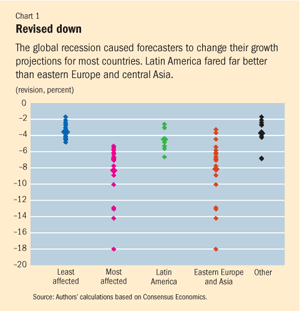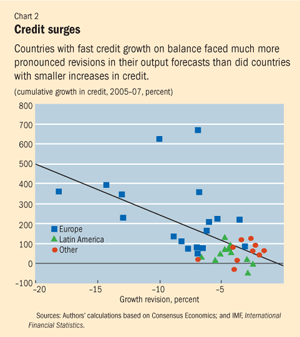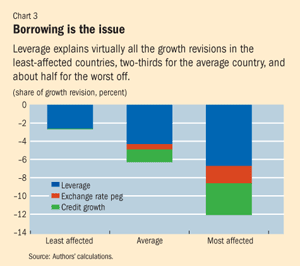Differential Impact
Finance & Development, March 2010, Volume 47, Number 1
Pelin Berkmen, Gaston Gelos, Robert Rennhack, and James P. Walsh
Why some countries were hit harder than others during the global crisis
THE global financial crisis that originated in the advanced economies dealt a blow to growth in the rest of the world during 2008–09. Some countries, however, fared better than others. Did their stronger performance reflect differences in trade or financial openness, underlying vulnerabilities to external forces, or the strength of their economic policies, which helped insulate them from global shocks?
To examine why some countries did better than others, we focused on revisions in gross domestic product (GDP) growth forecasts before and after the crisis for a sample of 40 emerging market countries and for a larger sample of 126 developing countries (which included emerging markets). We then assessed the importance of a wide range of factors that could explain differences in the size of these forecast revisions. Using forecast changes allows us to bypass many otherwise difficult issues—for example, to control for differences in growth rates that are the result of differences in levels of development or cyclical positions, or for other factors unrelated to the impact of the crisis. In addition, it allows us to incorporate the expected short-term effects of policies. We used private analysts’ projections from Consensus Forecasts (Consensus Economics) to calculate the change in the growth forecast for 2009 between January–June 2009 and January–June 2008. We also used changes in growth forecasts from the IMF’s World Economic Outlook (WEO).

Growth forecast revisions for 2009 range from –18 percent to –1.5 percent, with the largest growth collapse occurring in eastern European and central Asian countries; the effects in Latin America were much more contained (see Chart 1). Our analysis suggests that countries with more leveraged domestic financial systems and more rapid growth in lending to the private sector tended to suffer larger downward revisions to their growth outlook. Exchange rate flexibility clearly helped buffer the impact of the shock, as countries with pegged exchange rate regimes fared significantly worse.
How the crisis may have spread
There are a number of ways the crisis may have spread from advanced economies to the rest of the world, including directly through trade linkages and financial linkages. Moreover countries with vulnerabilities—such as high current account deficits, high indebtedness, low reserves, or strong credit growth—may have been more likely to feel the effects of a global recession. Conversely, countries with effective policies—such as flexible exchange rates, a strong fiscal position, or a credible institutional framework—should have withstood the crisis better.

For the 40 emerging markets, financial factors appear to have been key in determining the size of the growth revision. In particular, countries that experienced strong credit booms were more vulnerable to the slowdown: leverage, measured as the credit-to-deposit ratio, and cumulative credit growth turn out to be significant explanatory variables across various specifications. The results suggest that, if the countries in the most leveraged quartile of the sample (with average leverage of 185 percent of GDP) had had the same leverage ratios as the countries in the least leveraged quartile (83 percent), their growth revisions would have been, on average, 4.1 percentage points smaller. The effect is only slightly smaller with credit growth: if the quarter of countries with the fastest cumulative credit growth (averaging almost 350 percent) had had the same credit growth as the countries in the slowest credit growth quartile (with average growth of only 14 percent), their growth revisions would have been 3.3 percentage points smaller (see Chart 2).
Countries with more flexible exchange rates tended to experience smaller growth revisions. For the most part, downward growth revisions for countries with pegged exchange rates were larger (on average, in excess of 2 percentage points) compared with countries with more flexible exchange rates.
The stock of international foreign exchange reserves—measured in numerous ways, such as share of GDP, exports, or short-term debt—did not have a statistically significant effect on the growth revisions. This result is similar to that found by Blanchard (2009). This may reflect the possibility that the value of international reserves diminishes sharply once they grow above a level considered sufficient to guard against risks. In fact, several of the countries with the largest growth revisions, particularly in central and eastern Europe, had levels of international reserves similar to those in some of the less affected countries in Europe and Latin America.
On fiscal policy, although the evidence is somewhat less strong, there is some indication that the primary fiscal gap (the difference between the actual primary balance and one consistent with keeping public debt constant as a share of GDP) is positively associated with better growth performance. This corresponds with the notion that countries with prudent fiscal policies prior to the global crisis were less prone to confidence crises and were in a better position to adopt stimulus measures during the slowdown.
Trade linkages
We also used the WEO forecast data set (which has a wider coverage than Consensus Forecasts) to examine growth revisions for 126 developing economies (including emerging markets) to explore whether other channels, such as trade linkages, mattered for a broader set of countries.
Interestingly, the trade channel appears to matter in this sample, although not for emerging markets. Although the degree of trade openness does not appear to be decisive, the composition of trade does make a significant difference. In particular, the share of commodities (both food and overall) in total exports is associated with smaller downward growth revisions. The share of manufacturing products in total exports is correlated with worse growth performance for all developing countries, a relationship already noted in the IMF’s Regional Economic Outlook: Asia and Pacific (2009). This is consistent with the notion that countries exporting manufacturing goods to advanced economies seem to have been hit hard by the decline in demand from these markets, while countries exporting food appear to have fared better.
More generally, the results are in line with the notion that the transmission of shocks to countries with lower financial linkages to the world (such as low-income economies) tend to occur predominantly through trade, whereas the financial channel is more relevant for countries with close financial ties to the advanced economies, where the crisis originated. Clearly trade finance, which declined sharply at the end of 2008, was a financial channel that affected nearly all economies—advanced, emerging market, and developing.
Policy lessons

For the emerging market countries, the main avenue of transmission of the shock appears to have been financial channels, particularly through rapid credit growth and high leverage, with damage aggravated by pegged exchange rates. Leverage explains virtually all the growth revision for the least affected countries in the sample, roughly two-thirds of the revision for the average country, and slightly more than half the revision for the countries most affected by the crisis (see Chart 3). Credit growth explains a significant share of the growth revision for the average country as well as those most affected. None of the least affected countries in the sample had a pegged exchange rate; such limited exchange rate flexibility explains a substantial share of the growth revision of the most affected countries. There is also some evidence that trade linkages played a role in the transmission of the crisis, especially among developing countries not considered emerging markets.
This early attempt to explain why some developing countries and emerging markets fared better than others suggests some—preliminary—policy lessons:
- Exchange rate flexibility is crucial to dampen the impact of large shocks.
- Prudential regulation and supervision need to aim at preventing vulnerability buildups particularly associated with credit booms, such as excessive bank leverage.
- There is some—weaker—support for the notion that a solid fiscal position during good times creates some buffers that allow countries to conduct countercyclical fiscal policies during shocks, such as those brought about by the global crisis.
The results here are preliminary. More research will be needed for a more detailed understanding of the effect of policy responses and other institutional and structural factors on the duration of recessions in each country and the speed and size of the recovery in growth.
This article is based on IMF Working Paper 09/280, “The Global Financial Crisis: Explaining Cross-Country Differences in the Output Impact.”
References
Blanchard, Olivier, 2009, “Global Liquidity Provision,” presentation at the Financial and Banking Conference of the Central Bank of Argentina, August 31.-
Consensus Economics, Consensus Forecasts (various issues).-
International Monetary Fund, World Economic Outlook, various issues (Washington).
———, 2009, Regional Economic Outlook: Asia and Pacific (Washington, May).


